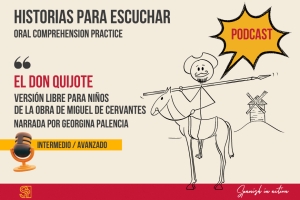If you are a Spanish student, you may have asked yourself, or asked your teacher, what is the most difficult thing to learn in the Spanish system. Our answer is:
-the quantity and use of pronouns,
-the number of conjugations of the different tenses of the verbs,
-gender and concordance.
Right away, when responding, we add:
The first two are learned in the progress of levels of complexity, calmly and step by step. We are doing revelations, explanations, and practice.
The third, gender and its concordance, although it is true it has grammatical principles that must be known, it will only be with the identification and use of the word that it will be recorded in memory with the corresponding gender. So many times the student will feel certainties, but other times he will be disconsolate because he will seem to have to turn on the diviner.
Where do the certainties come from?
To give the student key information to understand the characteristics of the genre in Spanish. For that we expose those keys here.
We recommend you use this material to study and understand the very particular distinctions that gender has in Spanish.
What is gender for?
In Spanish, gender serves to differentiate between masculine and feminine.
But is the difference between masculine and feminine gender grammatical or human or sexual?
The grammatical gender mark tends to also identify the human gender, but many times, both in nouns and in adjectives, there is no such coincidence or, in the case of adjectives, they do not admit gender inflection. Example: the intelligent man, the intelligent woman. And when it is not about nouns that designate non-humans, the gender function is only grammatical. Example: flowers. The noun flower is feminine and many flowers are a masculine grammatical gender, that does not mean that there are flowers of different sexes. The gender brand is not a sex brand.
Are there only two types of gender: female and male?
The two grammatical genders of Spanish are feminine and masculine, but in the classification of names there are also four other genders: common, epicene, ambiguous, and neuter. Those classifications also regulate the brands or not of the genre.
Why is the gender brand in Spanish so repetitive, is it not enough just once?
It is one of the characteristics of the syntax of Spanish: the necessary gender mark in each of the elements of the noun phrase: article, noun and how many times it is described with an adjective, it must also have its respective mark. Although in other languages it is necessary only once, or even not at all, in Spanish it is mandatory.
And something curious, which is the norm, if there is more than one name, and one is masculine and the other feminine, the agreement is always in masculine: the apartment buildings, parks and houses in that city are very beautiful.
Finally, how do we know if it is female or male?
Masculine nouns:
● Almost, read well: almost, all words ending in -o.
● Some words that end in other vowels or consonants.
● Names related to geography: rivers, mountains, volcanoes, isthmus, canals: el Amazonas, el Everest…
● The months and days of the week: Fue un diciembre muy lluvioso, el marzo ventoso.
● Almost all the winds: el siroco, el levante, el poniente, el terral, etc.
● The cardinal points: el norte, el sur, el este, el oriente, el oeste, el este, etc.
● The numbers: el siete, el doce.
Feminine nouns:
● Almost, read well: almost, all words that end in -a.
● Some words that end in other vowel or consonant letters.
● The letters: la jota, la eme, etc.
● There are names ending in -a that can be masculine or feminine depending on the meaning: el cura/la cura, el cabeza/la cabeza, etc.
But be careful, you also need information on the so-called common, epicene, and ambiguous, what are they?
Common:
● Names that have a single ending and can be used with the masculine or feminine article: el periodista/la periodista, el testigo/la testigo, el canciller/la canciller, etc.
● Almost all those ending in -ante and -ente: estudiante, atacante, saliente, paciente, gerente, etc. Although some of them have also a femenine version: presidente/a, cliente/a, asistente/a.
Epicene:
The names of animals that do not change for the male or the female: el ratón, la rata, la rana, el sapo, el jabalí, la tortuga, el águila, la llama. In these cases, to differentiate them, it is said: male mouse / female mouse, male stingray / female rat, male eagle, female eagle, etc.
Ambiguous:
The names that interchangeably admit the masculine or feminine article: el mar /la mar, el puente/la puente, el sartén/la sartén, etc. But the truth is that they are very few.
And what about the gender of the names of professions and positions?
The names of the professions and positions that were traditionally held only by men were only male. Some, when women did these jobs, became common gender, and the third and last step was the split into male and female gender: 1. el abogado, 2. el/la abogado, 3. el abogado/la abogada.
This last change has not yet finished, but the books on the use of Spanish advise that –especially in the names of professions and positions ending in -o- the feminine forms, ending in -a: el médico/la médica, el músico/la música.
Is Spanish a macho language?
Not in our opinion, and may the feminists forgive us. The masculine is generic in Spanish and in the other Romance languages.
The masculine also functions as an “unmarked gender”, that is, if it is not specified, it works for the masculine and the feminine.The feminine is a “marked gender”, that is, it only works for the feminine: “los maestros del colegio “includes male and female male and female teachers, and”las maestras del colegio “only mentions female teachers.
How and when to form the feminine from the base of the masculine?
The masculine names ending in -o form the feminine one, changing the –o by an -a:camarero/camarera, médico/médica, alumno/alumna, gato/gata.
But there are also feminine ones with special endings, such as those formed with the endings –ina, –esa or –isa: rey/reina, héroe/heroina, príncipe/princesa, conde/condesa, poeta/poetisa/, sacerdote/sacerdotisa, etc.
If there are so many clear answers for gender identification, why is it one of the difficulties of Spanish? Because the last question would be When to turn on the diviner?
Remember above we emphasize the almost, read well: almost, well, in addition to knowing and applying the rules that we have exposed, and paying close attention to the entire line of agreement, you should know that in this almost there is a world of necessary divination because there is no explanation. And that’s ‘la mayor problema’, as many students would say.
Problema, for example, has the vocal characteristic to be feminine, but it is not. And we could not say that it is because men are the ones who cause problems and that is why it is masculine. Although we use it as a bad joke. No. This word, like many others: system, situation, program, etc. are part of that world of gender divination and that is when it is the turn to register in memory.
If you are a Spanish student, these lines are definitely made for you, and if we haven’t answered some of your questions, ask them here.
Bye!



